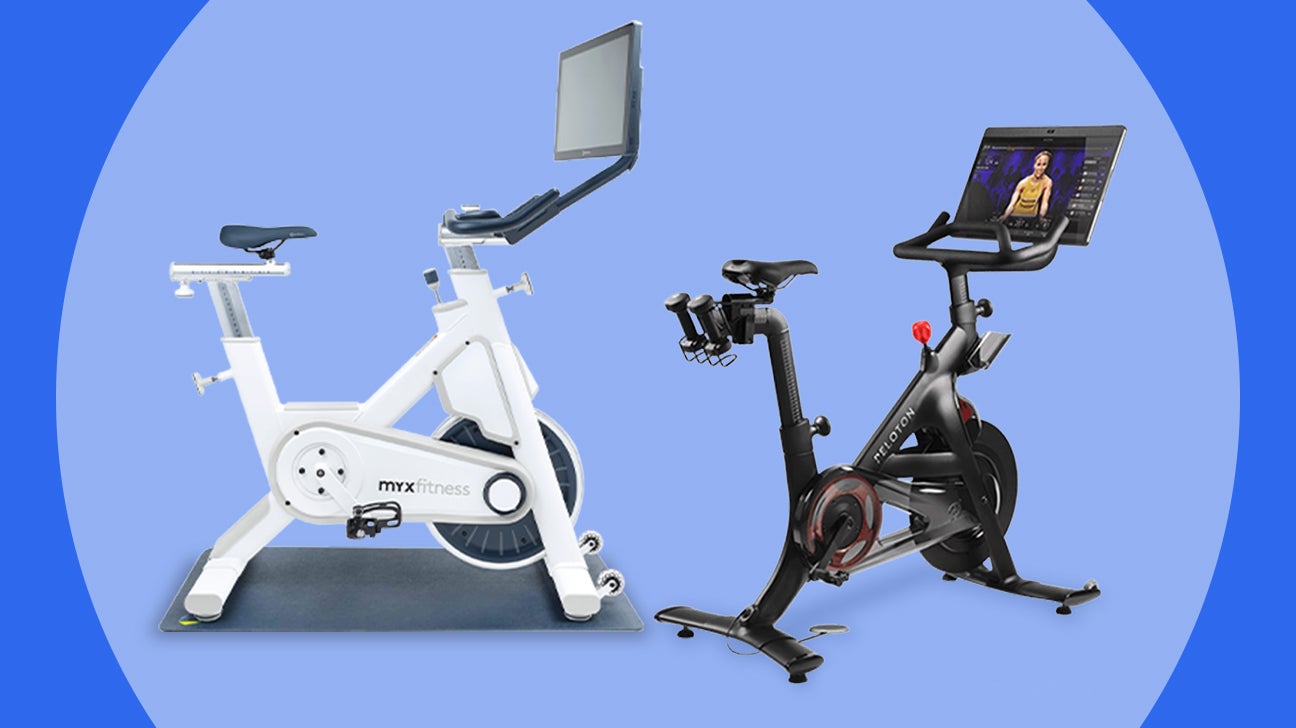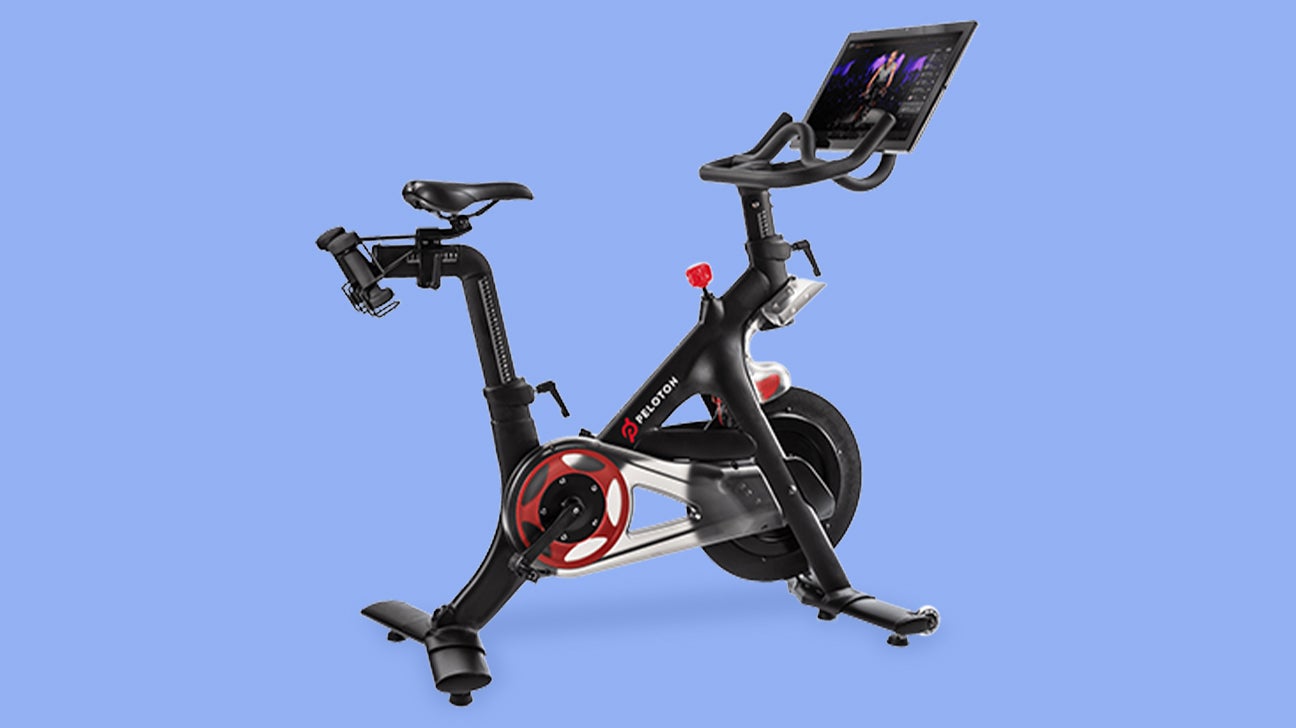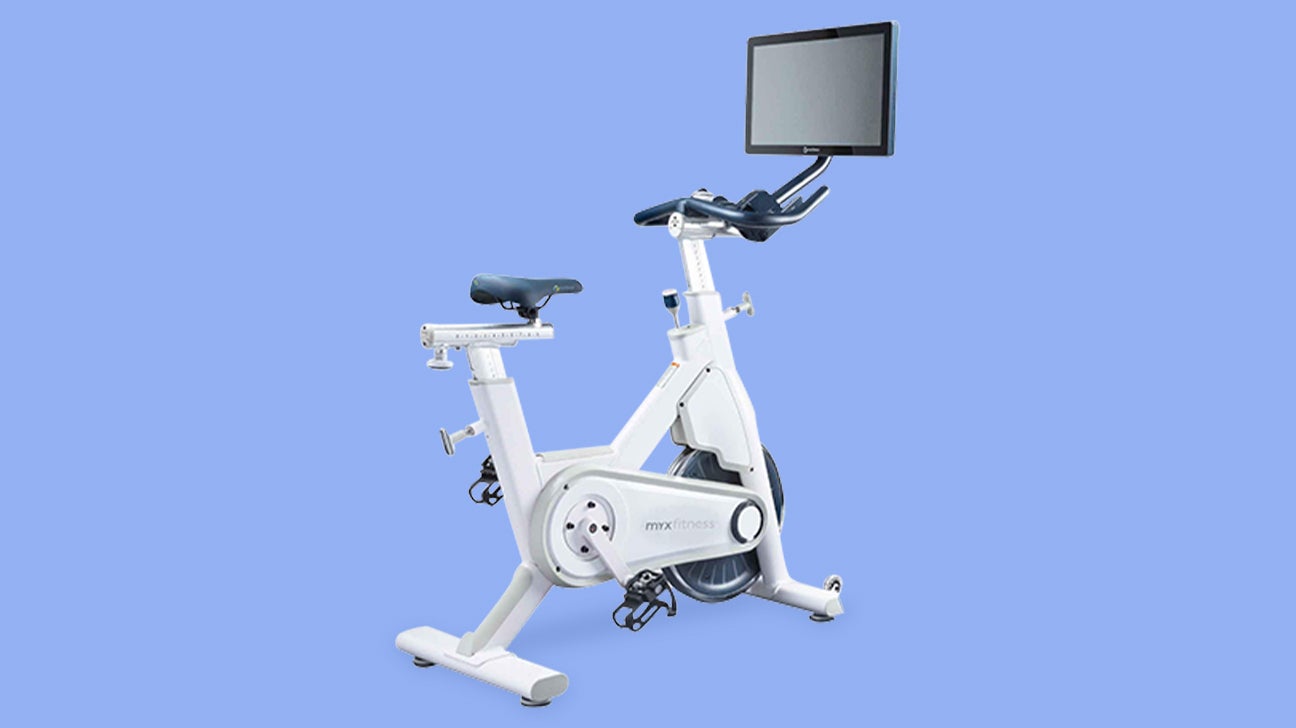Both Peloton and MYXfitness offer at-home stationary bikes that are all about recreating that cycling-class feel, thanks to their impressive HD touch screens and access to streamed trainer-led classes. While the two machines have a lot in common, they also have some key differences that might totally change your mind about which one to get.
We put our research pedal to the metal to help you decide between these two options. Let’s dive in!

| Dimensions | Touch screen | Resistance type | Classes and trainers | Adjustable handlebars? | Bike cost | Subscription cost | |
| Peloton | 59 L x 23 W x 53 H in. | 21.5-in. HD, doesn’t swivel | magnetic | thousands of classes with world-class trainers | yes | $1,495 | $39/month |
| MYX II | 54 L x 21 W x 47 H in. | 21.5-in. HD, swivels! | friction | access to MYX+Openfit and Beachbody classes | yes | $1,399 | $29/month |
Tell me about Peloton, baby!

The OG Peloton Bike has long been considered the gold standard for at-home cycling. So let’s take a closer look.
The basics: Everything to know about the Peloton Bike and Bike+
Both of Peloton’s bikes are pro-level stationary bikes designed to give riders an elite, interactive riding experience.
Cost
Let’s address the elephant in the room: Yes Peloton is expensive, but the price of the original bike recently dropped to a more affordable (but still pretty expensive) $1,495. But if you’re looking for the upgraded model with (slightly) improved specs, the price jumps by $1,000.
On the plus side, you’re paying for quality — most reviewers say this bike is the creme de la creme. It all comes down to your budget. (Don’t forget: Many affordable, good-quality alternatives exist.)
Features
The bike itself has a heavy-duty flywheel and magnetic resistance for an ultra-smooth ride. While you can purchase toe cages for a more casual ride in sneakers, the Peloton’s pedals require actual cycling shoes that clip in (specifically, Delta-compatible cleats).
One potential downside, depending on how you look at it (pun intended), the screen on the Peloton Bike doesn’t swivel, meaning you can’t rotate it when you want to do off-bike workouts. If a swiveling screen is important to you, you’ll have to fork over a whopping $2,495 for the Bike+.
And TBH, the $1,000 jump in price for the newer bike doesn’t really give you all that much more. Here are the key differences between the two:
- The Bike+ has a slightly bigger (by 2.3 in.), anti-reflective screen.
- The Bike+ touchscreen swivels 360 degrees.
- The Bike+ resistance can automatically be adjusted based on class instructor’s cues.
The classes
The HD touch screens and built-in app give you access to thousands of branded live and prerecorded classes, all led by pro trainers whose No. 1 goal is to make you hustle. The music is pretty sweet too.
If you’re the kind of person who gets revved by competition, you’ll be happy on the Peloton. When you’re riding along in class, you can see how you stack up to others with the on-screen leaderboard (and maybe push it a little harder if you want to get ahead). But if you hate leaderboards (which we kinda do), you can also swipe it away and focus on your own metrics.
Peloton’s classes are mainly output-based (resistance + cadence), so the harder and faster you push, the higher up on the leaderboard you climb.
On days you’re not cycling, you can also access cross-training classes like strength training, yoga, meditation, running, walking, barre, and Pilates workouts. This is where the Bike+’s swiveling screen comes in clutch — but you can also access classes on your phone, tablet, and other streaming devices like Apple TV.
How are Peloton’s classes?
I’m a big fans of Peloton’s cycling classes and basically obsessed with the different trainers (hi, Cody Rigsby!!!).
You have a huge amount of classes to choose from, so you’ll never get bored. You can also filter by class length, type (HIIT, low impact, etc.), instructor, and music — so it’s super easy to find a class that fits your vibe at any given moment. The classes are also always challenging and it’s fun to see yourself get better and better over time.
The thing I don’t like about Peloton’s cycling classes is the leaderboard. I actually hate all output-based leaderboards because they really bum me out. Even if I’m kicking a$$ and improving my total output every class, I could still be #40,000 out of 80,000 people who have taken that class. They’re just not motivating for me — but I know some people that love watching their username climb the ranks during class.
When it comes to noncycling classes, I’ve only ever taken strength training (including pilates and barre) and yoga classes — and they’re not my favorite. The classes themselves are challenging and engaging, but I have two main issues with them.
First, there aren’t a ton of longer strength training classes. If you’re the type of athlete looking for consistent 45 minute strength training workouts, you’ll burn through the options pretty quickly.
Second, while there are a few beginner programs (like beginner strength and yoga), there isn’t a great way to create a program for more advanced classes — so you’re basically just left taking random classes. This is a big bummer for people who want structured progression over time (like me!) to ensure they’re getting stronger or improving flexibility with every workout.
tl;dr: Peloton classes and instructors are awesome, fun, and challenging — especially the cycling classes. But there isn’t an easy way to build a well-rounded workout program that constantly challenges you.
Ruby Thompson, Market Editor
The bike: A deep dive into features, design, and specs
Ready for the scoop on the features? Right on.
| Peloton Bike | Peloton Bike+ | |
| Cost | $1,495 plus $39/month subscription | $2,495 plus $39/month subscription |
| Dimensions | 59 L x 23 W x 53 H in. | 59 L x 22 W x 59 H in. |
| Weight | 135 pounds (lbs.) | 140 lbs. |
| Touch screen | 21.5-in. HD | 23.8-in. HD, swiveling & anti-reflective |
| Resistance type | magnetic | magnetic |
| Rider capacity | 6 feet (ft.) 4 in. and 297 lbs. | 6 ft. 4 in. and 297 lbs. |
| Handlebar height and depth adjustability | height only | height only |
| Shipping | free; ships out within 2 weeks of order | free; ships out within 2 weeks of order |
| Returns | can return any time during the 30-day at-home trial period | can return any time during the 30-day at-home trial period |
| Warranty | 12-month limited warranty on screen and most original bike components; 5 years coverage on frame | 12-month limited warranty on screen and most original bike components; 5 years coverage on frame |
| Assembly | COVID-friendly assembly format delivers assembled bike to your front door. | COVID-friendly assembly format delivers assembled bike to your front door. |
Peloton pros
- magnetic resistance = ultra-smooth ride
- access to thousands of live and recorded classes
- super-motivating pro trainers and class leaderboard
- great music in classes
- trainers can automatically adjust resistance on bike+
- free delivery and assembly
- 30-day returns
Peloton cons
- expensive $$$
- expensive monthly subscription
- cheaper bike doesn’t have swiveling screen
- hard to create a structured workout program
Should I make a MYX II mine?

MYXfitness has been BUSY lately. The company recently merged with Openfit and Beachbody and released the second iteration of its bike: The MYX II.
The basics: Everything to know about MYX II
The MYX II is a newcomer to the at-home cycling market — but what it lacks in legacy and prestige, it makes up for in other sweet features.
Cost
The MYX II bike is positioned as a more affordable alternative to Peloton, though the price difference isn’t huge now that Peloton dropped the price of its bike. Both the bike and the monthly classes are slightly less expensive: $1,399 with a $29/month subscription.
Features
The bike has a similar ergonomic feel to the Peloton. The main difference is the flywheel — it uses friction resistance instead of magnetic, which makes the ride feel a little less smooth. The pedals are also compatible with cycling shoes or regular sneakers.
The bike also has a 21.5-in. HD *swiveling* touch screen without draining your savings. Plus, there’s an 8-megapixel camera that you can use for personal training sessions and group class broadcasts.
Lastly, the bike also comes with a heart rate monitor to use during classes — which are mainly heart rate-based training. You can also sync it up with your Apple Watch if you don’t love wearing other heart rate monitors.
Classes
Now that MYXfitness, Openfit, and Beachbody are all one company, MYX has a lot of class options. But TBH, the whole thing is a little confusing, so we’ll break it down for you.
MYX merged all of its content with Openfit’s (now called MYX+Openfit), so you can now access all of those classes with one subscription.
But you can also choose to subscribe to Beachbody’s BODi platform — featuring the company’s classic programs like P90x and INSANITY — but you’ll have to pay an additional subscription fee for that (also $29/month).
Both platforms have a bunch of cycling and noncycling classes, but there are some key differences between BODi and MYX+Openfit:
- MYX+Openfit classes are mainly heart rate-based training, which means you focus on your heart rate zones to determine your success in class (basically like Orangetheory). They also have a very personalized vibe to them — you feel like your instructors are your very own personal trainer.
- BODi classes are more intense by nature (one of them is literally called “INSANITY”). You can use the camera to take part in BODcasts, which are group classes where you can stream yourself working out on the class’s leaderboard. They’re a good option for people who want to replicate the feeling of in-person group classes.
But remember, you don’t have to pick between the two if you’ve got the extra cash and want both experiences. You’ll just have to pay two separate $29/month subscription fees.
How are MYX+Openfit classes?
I was pleasantly surprised by how much I liked the classes I took. They felt really similar to Peloton’s. The original MYX bike didn’t show you your resistance or cadence, but this one does — so you can see your output in addition to your heart rate zone during classes.
I’m also just so obsessed with heart rate-based training for cycling. It’s a much more accurate way to assess how hard you’re working during class. If you notice your heart rate isn’t high enough, you can kick up your intensity. And if it’s spiking really high, you can tone it down a bit too.
The instructors don’t have as big of personalities as Peloton’s — which I definitely missed — but that doesn’t take away from how challenging the workouts are.
I also really like that MYX+Openfit has strength training programs. You can opt in to a program that progresses over time, taking you from beginner moves to more advanced ones. This is a huge plus for beginners and advanced athletes alike.
When it comes to Beachbody, classes like INSANITY and P90X aren’t really my style, but they’re two cult workout programs that have stood the test of time.
The fact that you get the option to choose between these two with the MYX II is awesome — but I’m hoping the whole two platform thing becomes a little less confusing as the companies settle into being merged together.
tl;dr: The MYX II is a high quality bike with some amazing, high-tech features (hi, heart rate-based training!) and strength training programs. The whole experience feels super personalized, making it a great option for beginner and advanced riders. But if you’re interested in having trainers with big personalities and huge fan bases, it might not be the best choice for you (for now!).
Ruby Thompson, Market Editor
The bike: A deep dive into features, design, and specs
OK, on to the numbers!
| MYX II | |
| Cost | $1,399 plus $29/month subscription(s) |
| Dimensions | 55 L x 21 W x 47 H in. |
| Weight | 150 lbs. |
| Touch screen | 21.5-in. HD |
| Resistance type | friction |
| Rider capacity | 6 ft. 8 in. and 350 lbs. |
| Handlebar height and depth adjustability | yes |
| Shipping | free; ships out within 1 to 3 weeks of order |
| Returns | within 30 days |
| Warranty | 1 year |
| Assembly | free |
MYX II pros
- heart rate-based training
- can access MYX+Openfit *and* Beachbody’s BODi classes
- swiveling HD touch screen
- access to hundreds of trainer-led classes, including nonbike classes
- free delivery and assembly
MYX II cons
- not that much cheaper than Peloton
- slightly less smooth ride due to friction resistance
- good-but-not-amazeballs trainers and classes
- two different platforms for classes can be confusing
So… which one should I get?
Ultimately, this decision comes down to how you like to get your fitness on.
Peloton provides a high end riding experience with access to top-of-the-line classes. People generally agree that it’s one of the best at-home stationary bikes, so it makes sense that it would come with the highest price tag. If you’re a hardcore rider looking to replicate the cycling studio experience at home, this is the bike for you.
If you’re a beginner, excited about heart rate-based training, and want to save a few bucks, MYX II could be for you. You’ll still get a great ride and access to tons of classes. Plus, the swivel screen makes doing other workouts super convenient.

0 Commentaires